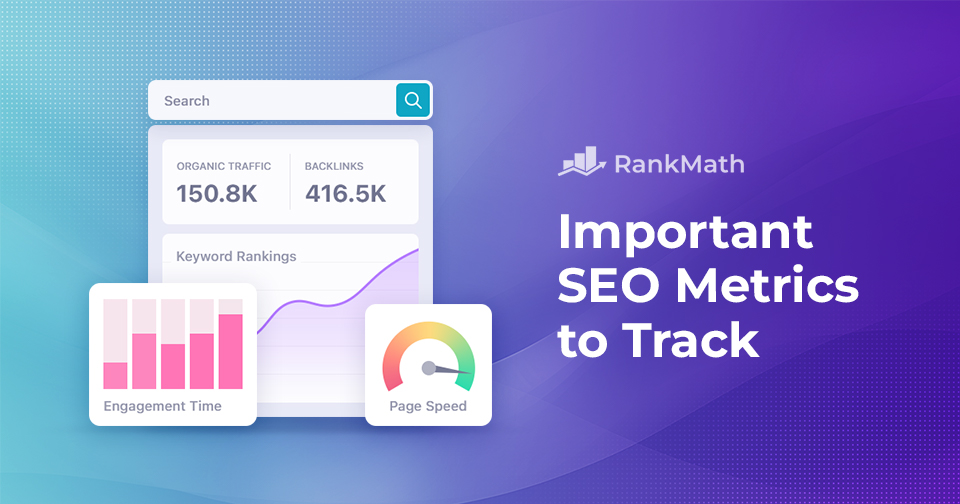What makes a website rank on the first page of Google? Why do some pages consistently get clicks while others remain unnoticed?
The answer lies in SEO metrics—they’re the key indicators that reveal how well your website is performing.
From organic traffic and keyword rankings to backlinks and user engagement, these metrics help you understand what’s working and where there’s room for improvement.
Essentially, SEO metrics serve as a performance review for your website, highlighting what’s working well and identifying areas that require extra attention.

In this post, we’ll discuss the most important SEO metrics you need to keep an eye on to boost your SEO game and build a strong online presence.
So, without further ado, let’s get started.
Table Of Contents
1 What Are SEO Metrics?
SEO metrics are data points that help you measure how well your website is performing in search engines. They offer insights into your site’s visibility, user behaviour, and overall SEO health.
By tracking these metrics, you can evaluate what’s working, identify areas for improvement, and fine-tune your strategy to meet your goals more effectively.
Some of the most important SEO metrics include: organic traffic, keyword rankings, Core Web Vitals, backlinks, indexed pages, click-through rate (CTR), page load time, bounce rate, conversion rate, engagement time, and other conversion-related metrics.
Regularly monitoring these indicators is essential for building a successful SEO strategy.
2 Important SEO Metrics to Track
Let us discuss these SEO metrics in detail.
2.1 Organic Traffic
Organic traffic refers to the number of visitors who land on your website through unpaid search engine results. These users discover your site by clicking links on search engine results pages (SERPs), rather than through ads or referrals.
Why Organic Traffic Matters
Organic traffic is one of the most valuable SEO metrics because it:
- Brings high-quality, intent-driven visitors to your site
- Supports long-term growth without ongoing ad spend
- Reflects your site’s visibility and relevance in search engines
- Helps increase brand trust and authority
How to Track Organic Traffic
You can track organic traffic from the Google Analytics 4 dashboard. Navigate to Acquisition → Traffic acquisition, as shown below.
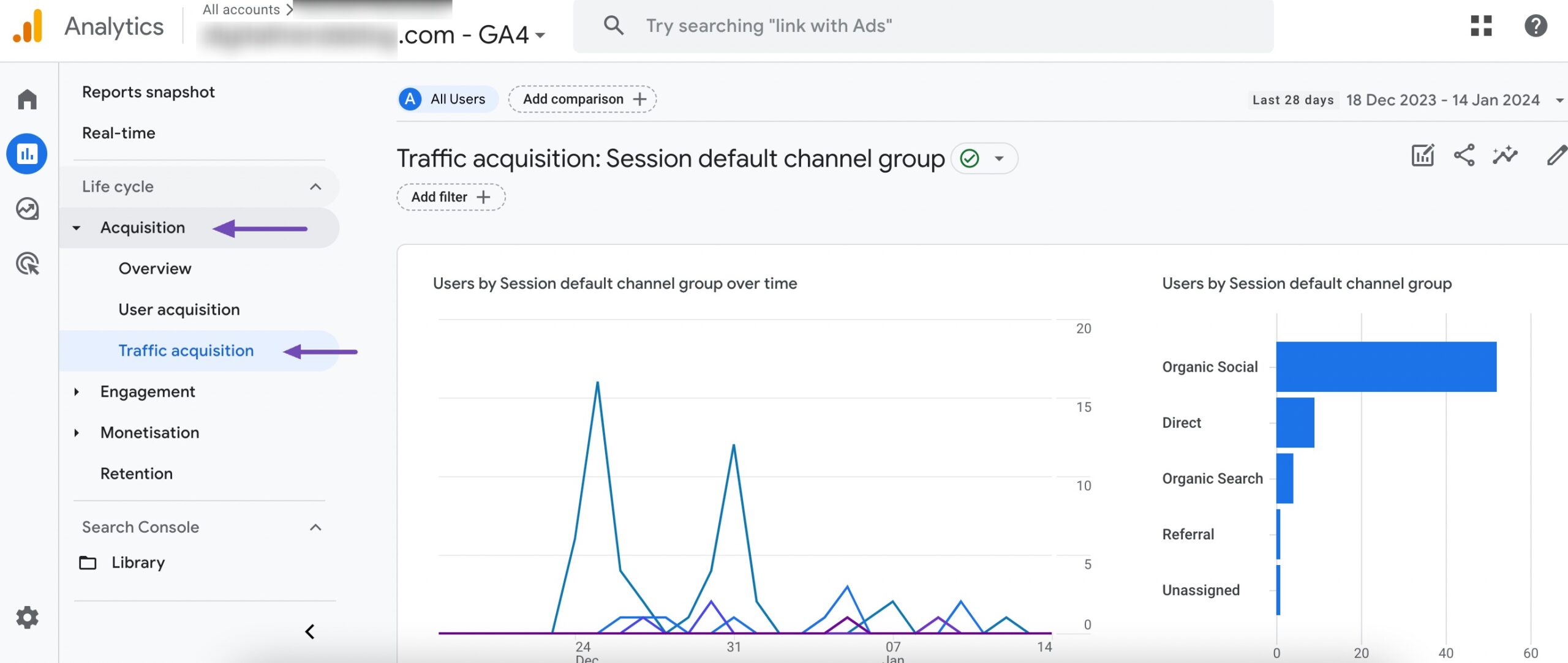
The Traffic acquisition report contains all the data on your website traffic, including traffic from organic search, direct, organic social, and referral.
As you scroll down, you will find additional traffic information categorized by channel.
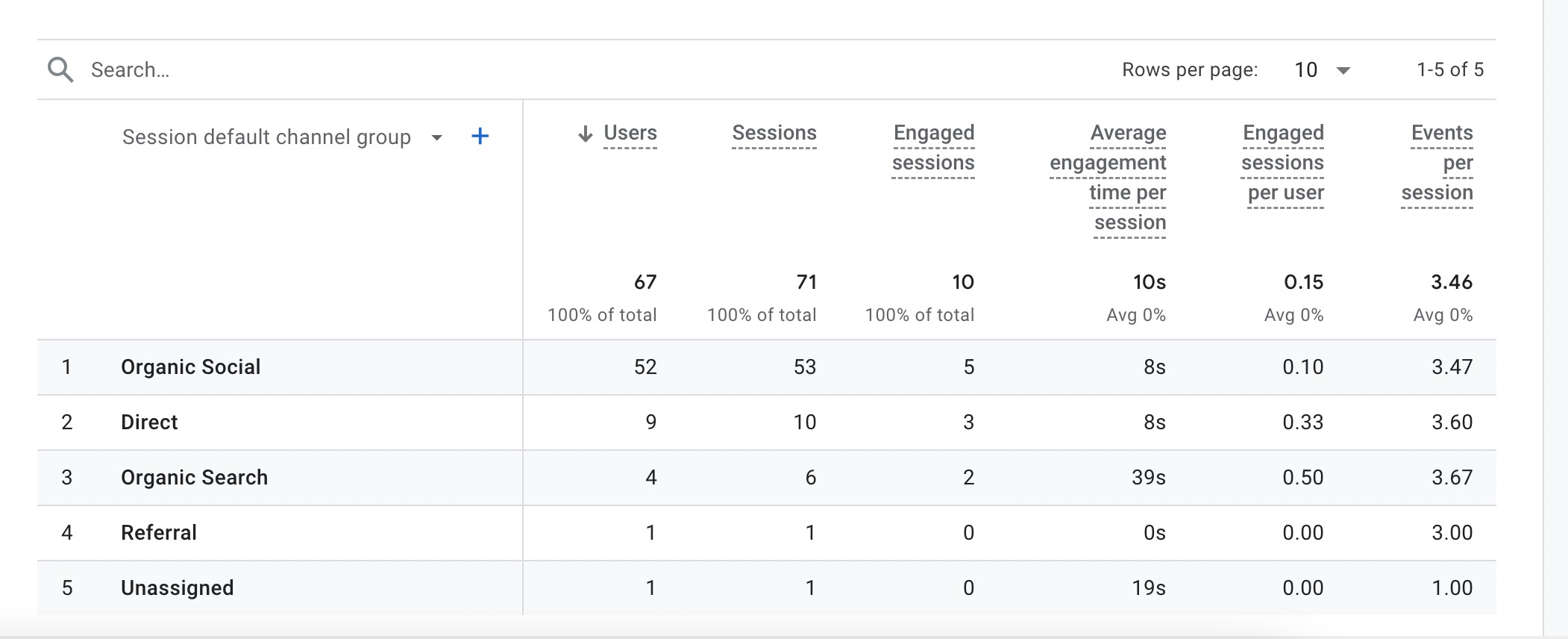
2.2 Keyword Rankings
Keyword rankings show where your website appears in search engine results for specific search terms. Higher rankings mean better visibility—and, consequently, better chances of attracting potential visitors who are actively searching for your content or services.
Why Keyword Rankings Matter
Tracking keyword rankings helps you:
- Measure the effectiveness of your SEO strategy
- Identify which keywords are driving traffic
- Discover opportunities to improve underperforming content
- Stay ahead of competitors in search results
In fact, according to our survey of over 700 WordPress SEO professionals, 57% reported a boost in organic traffic after using AI tools for SEO—a strategy that often includes smart keyword targeting.
How to Track Keyword Rankings
You can use Rank Math PRO’s Rank Tracker to keep track of keyword rankings in WordPress. A standout feature of Rank Math PRO is its capability to monitor the performance of your chosen keywords.
To do so, navigate to Rank Math SEO → Analytics → Rank Tracker from your WordPress dashboard, as shown below. Simply input your keywords into the Rank Tracker, and you can track their performance. This way, you gain insights into which keywords are delivering superior results for you compared to others.
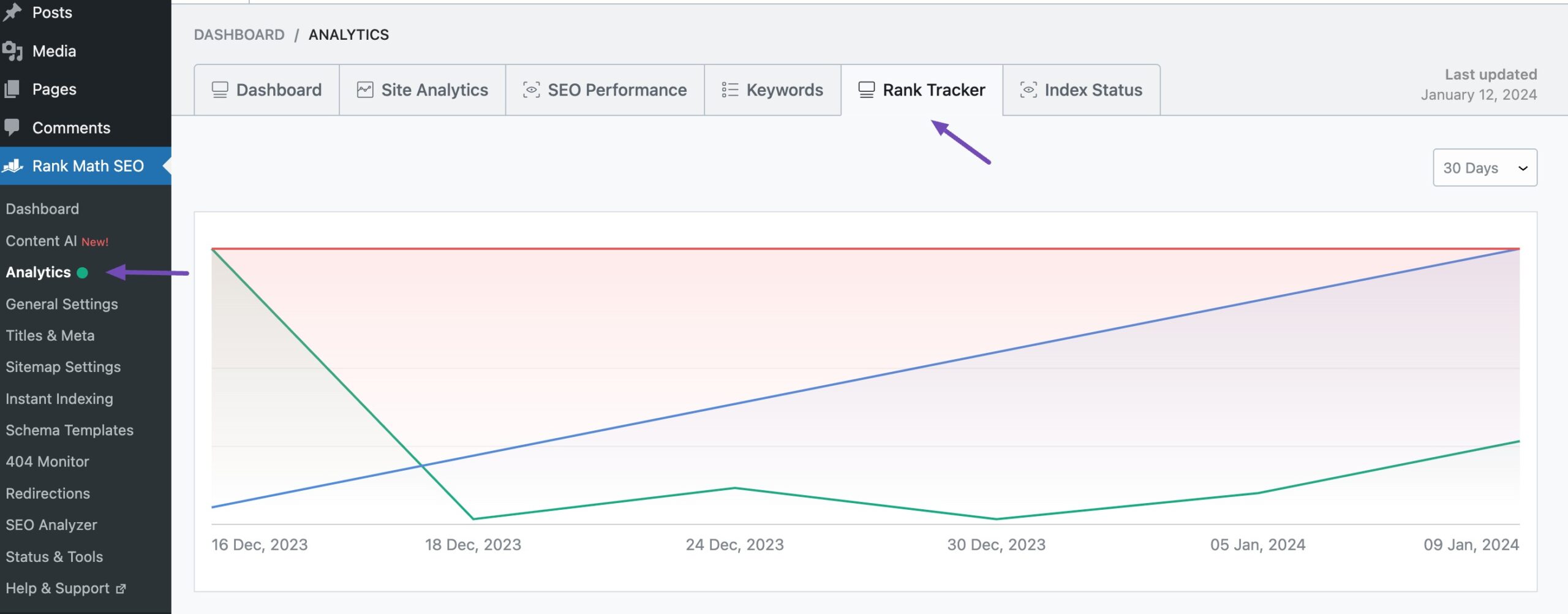
You can also use the auto-add focus keyword feature to import focus keywords from all your existing posts quickly. Plus, any new focus keywords you use in your posts will be automatically added, making the process completely hands-off.
2.3 Core Web Vitals
Core Web Vitals are a set of three key metrics that measure how users experience the speed, responsiveness, and visual stability of your website. These include:
- Largest Contentful Paint (LCP) – measures loading performance
- Interaction to Next Paint (INP) – assesses interactivity
- Cumulative Layout Shift (CLS) – evaluates visual stability
These metrics are essential for providing a smooth and satisfying user experience, and Google uses them as a ranking factor.
Why Core Web Vitals Matter
Improving your Core Web Vitals can:
- Reduce bounce rates by speeding up page load times
- Enhance engagement by making your site more responsive
- Boost SEO rankings by aligning with Google’s user experience standards
How to Track Core Web Vitals
You can track the Core Web Vitals in Google Search Console under the Core Web Vitals report.

Identify URLs that need improvement based on LCP, INP, and CLS benchmarks.
Refer to our dedicated tutorial on mastering Core Web Vitals to learn more about them.
2.4 Backlink Metrics
Backlinks—links from other websites pointing to yours—are one of the most powerful ranking factors in SEO. When a trusted site links to your content, it signals to search engines that your content is valuable and trustworthy.
Why Backlink Metrics Matter
Tracking backlinks helps you understand both the popularity and credibility of your website. Two key aspects to monitor are:
- Quantity: The total number of backlinks. A higher number generally indicates broader visibility and reach.
- Quality: The authority, relevance, and context of the linking site. High-quality backlinks from authoritative domains have a stronger impact on rankings.
Search engines reward websites that earn a diverse and authoritative backlink profile, often resulting in improved rankings and organic traffic.
How to Track Backlinks
You can use Google Search Console to track the external links to your website.
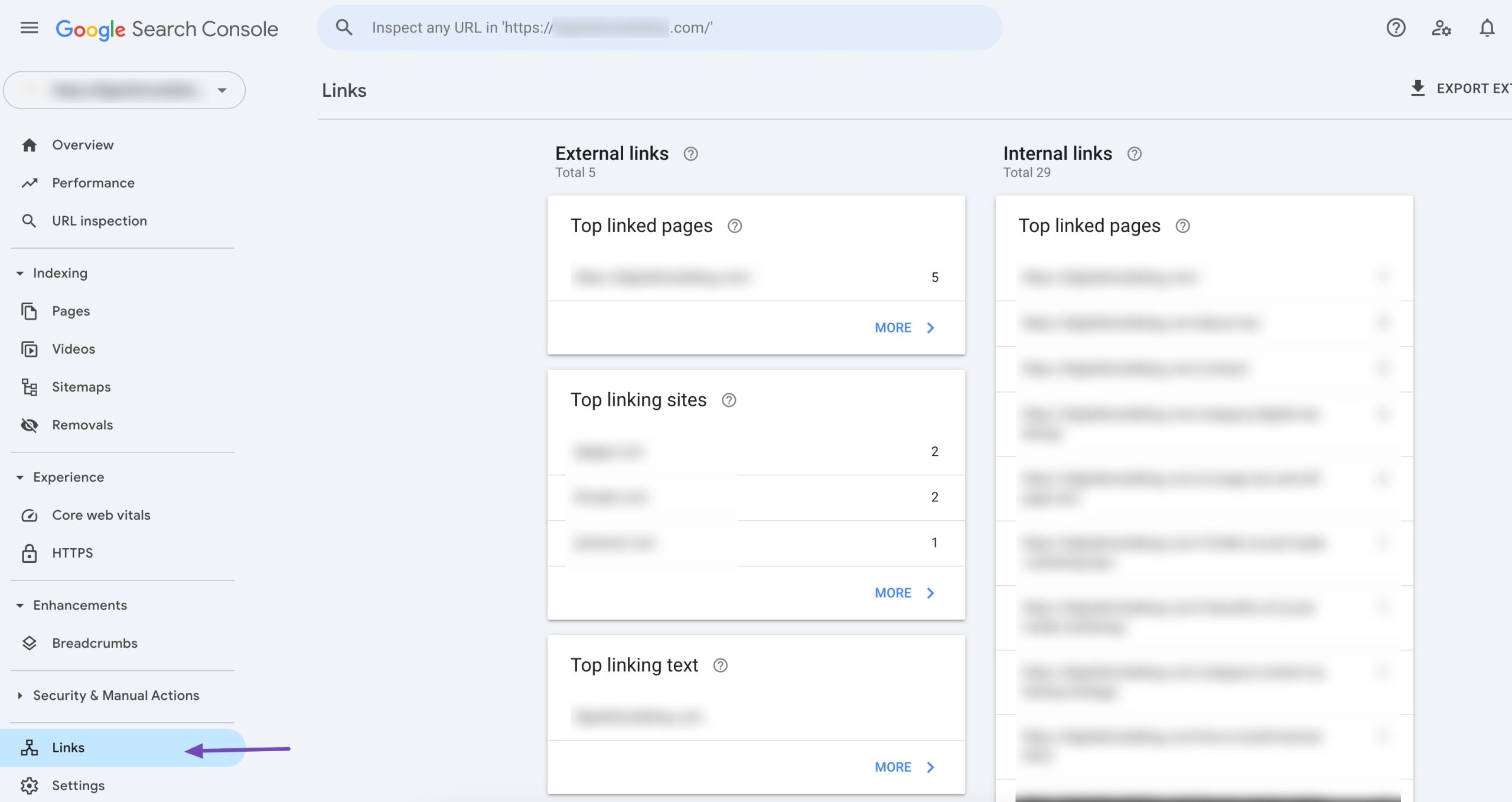
Also, tools such as Moz, Ahrefs, or Semrush allow you to monitor the number of backlinks and assess their quality based on factors like domain authority, relevance, and anchor text.
Balancing the quantity and quality of backlinks is key to building a strong SEO foundation and improving your site’s visibility in search results.
Refer to our dedicated tutorial on link building to discover strategies for earning high-quality backlinks that boost your SEO.
2.5 Indexed Pages
The indexed pages metric indicates the number of pages from your website that have been crawled and stored by search engines like Google. If a page is indexed, it means it can appear in search results when users search for relevant terms.
Why Indexed Pages Matter
Monitoring indexed pages helps you:
- Ensure important content is visible in search results
- Identify crawl or indexing issues
- Optimize site structure for better discoverability
Several factors influence indexing, such as your site’s architecture, content quality, internal linking, and how accessible your pages are to search engine crawlers.
How to Track Indexed Pages
You can track the indexed pages using the site:yoursite.com operator in Google search. The number of results is a rough estimate of how many pages Google has indexed.

Rank Math also helps you keep track of the indexed pages right in your WordPress dashboard.
Navigate to Rank Math SEO → SEO Analytics → Index Status tab, as shown below. Under this tab, you will get the real data/status of your pages as well as their presence on Google.
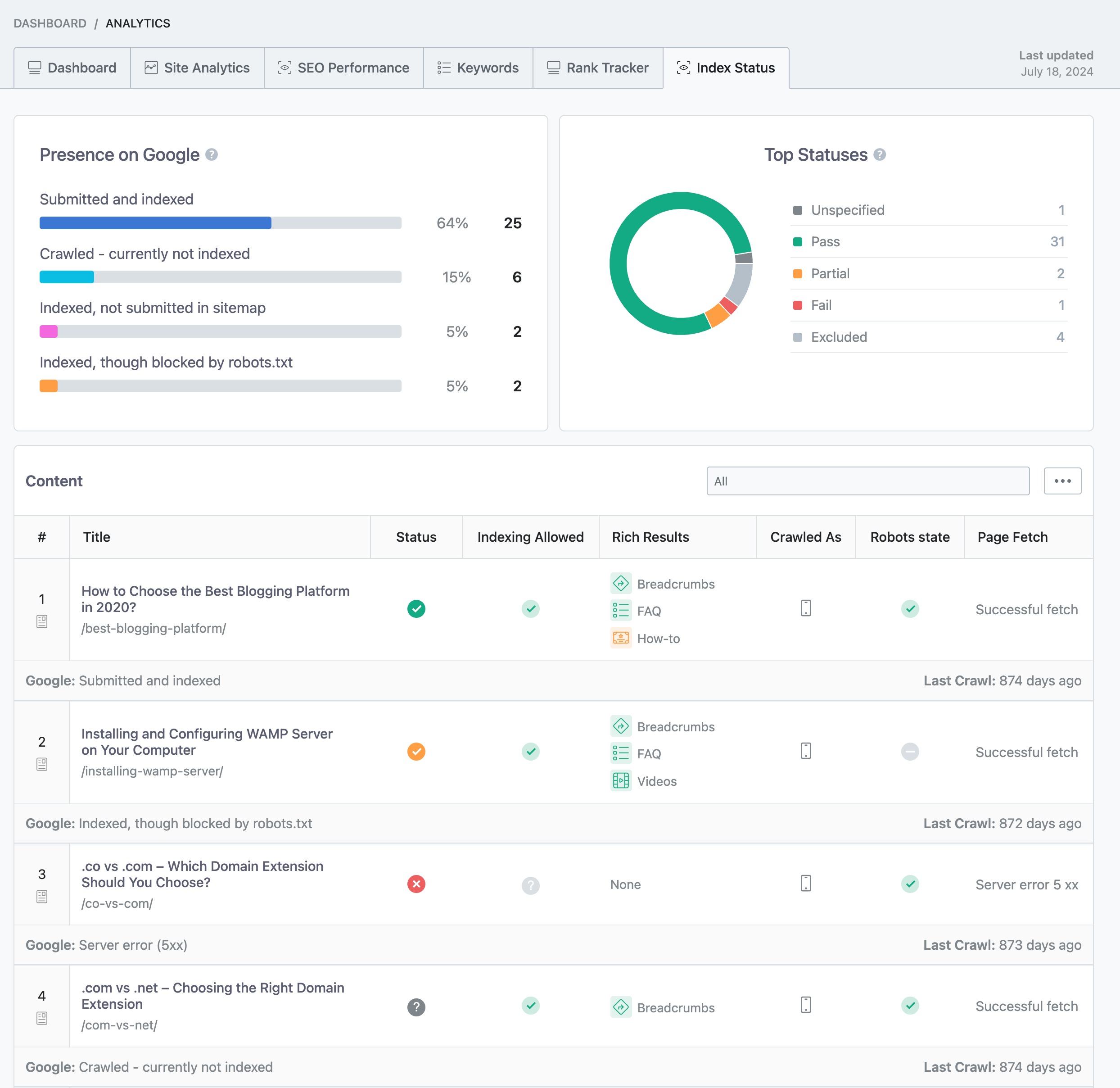
You can also use the Page indexing report of Google Search Console to find the number of indexed pages on your site.
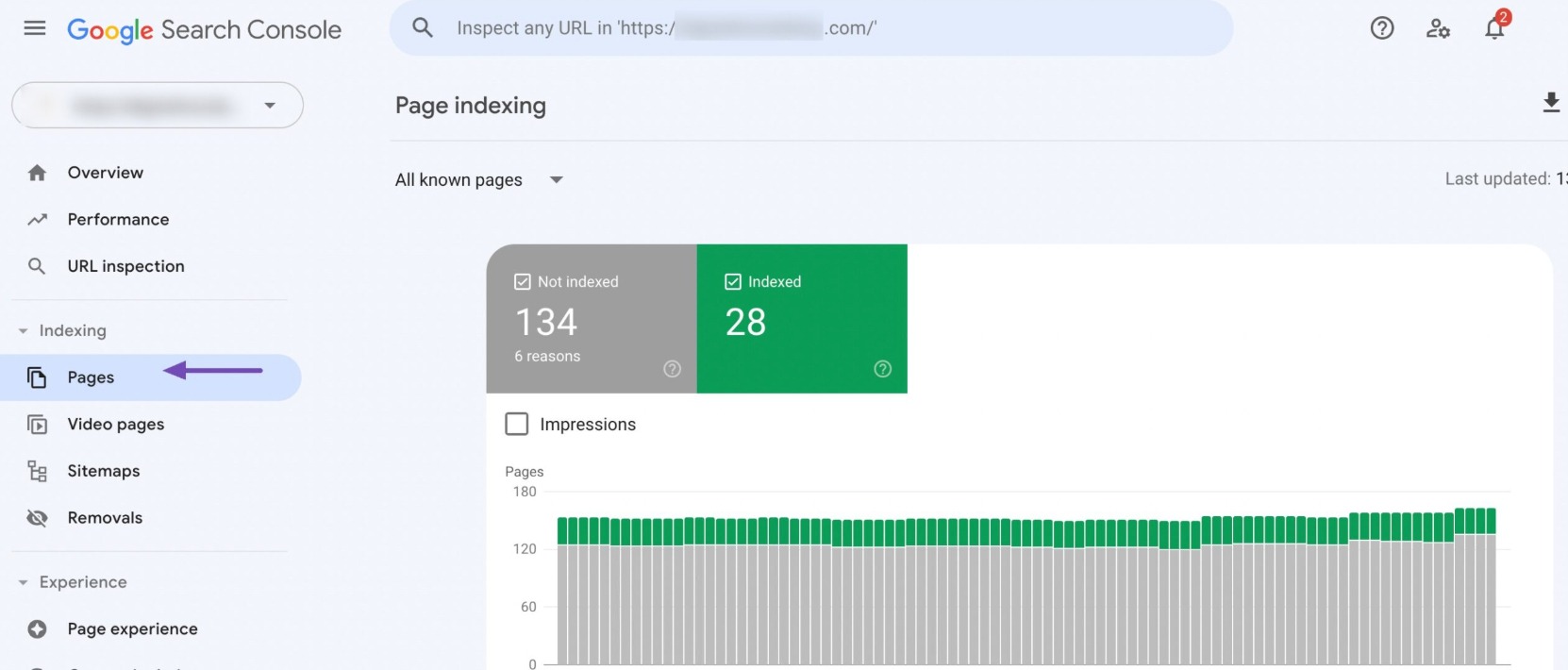
2.6 Index Coverage Errors
Index coverage errors occur when search engines encounter problems while trying to crawl or index certain pages on your website. As a result, those pages may not appear in search results, hurting your visibility and overall SEO performance.
Why Fixing Index Coverage Errors Matters
Unresolved indexing issues can:
- Prevent important pages from showing up in search results
- Lead to lower organic traffic
- Signal poor site health to search engines
How to Track Index Coverage Errors
You can track the indexing errors in the Page indexing report of Google Search Console.
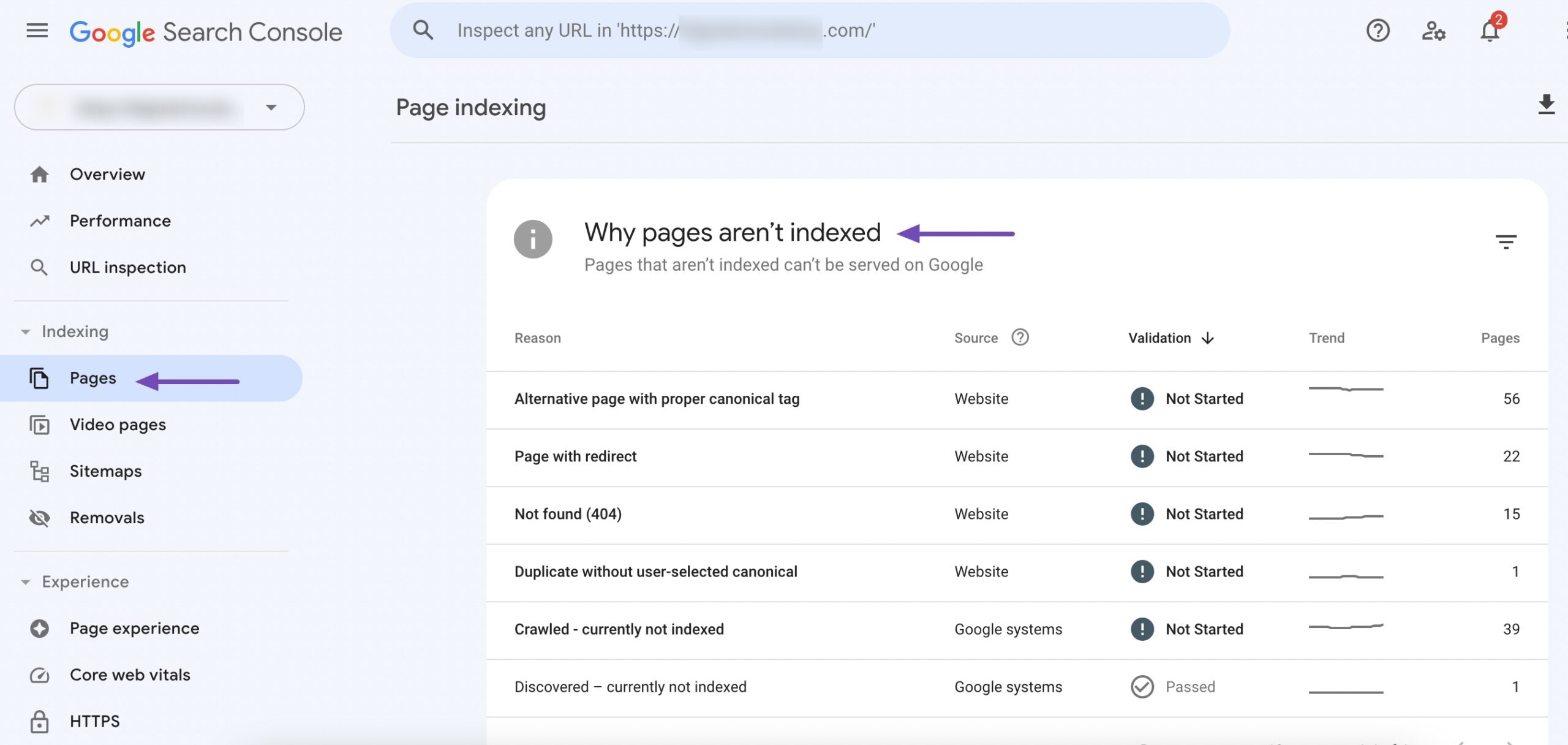
After clicking on an error, a list of affected URLs appears, and you can click the VALIDATE FIX button to resolve the issue.
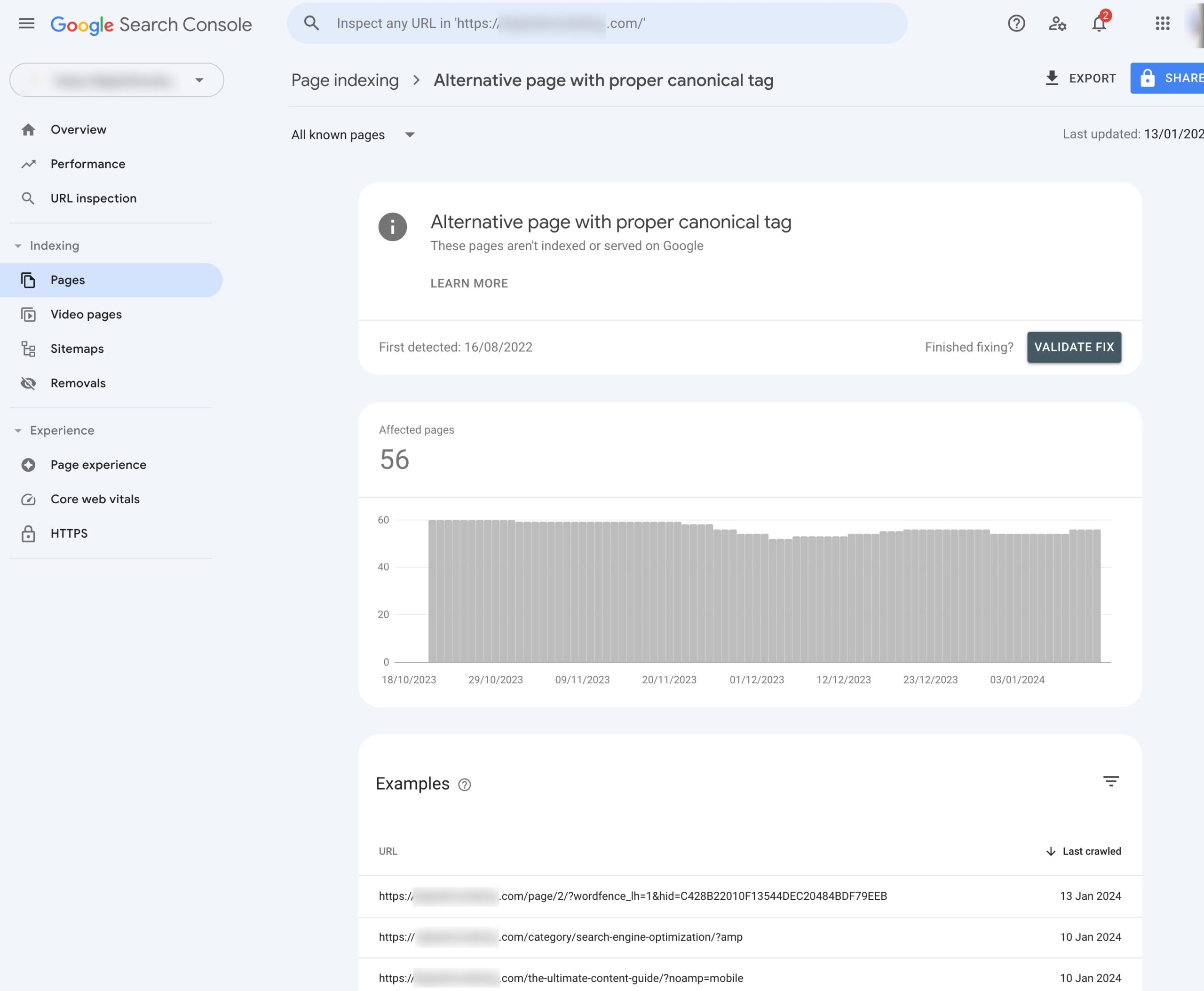
2.7 Conversion Metrics
Conversion metrics track the actions users take after arriving on your website, such as making a purchase, signing up for a newsletter, submitting a contact form, or downloading a resource.
While SEO drives traffic, it’s the conversions that reflect how well that traffic is turning into real business value.
Why Conversion Metrics Matter
Monitoring conversion metrics helps you:
- Measure the true ROI of your SEO efforts
- Identify which pages and keywords lead to meaningful actions
- Focus your strategy on what drives results, not just clicks
How to Track the Conversion Metrics
Utilizing tools like Google Analytics allows businesses to identify which keywords or landing pages are driving high conversion rates.
By understanding the keywords that lead to successful conversions, SEO strategies can be refined to target the most valuable and relevant terms, ultimately driving more conversions. Set up conversion goals in your GA dashboard (e.g., purchases, sign-ups).
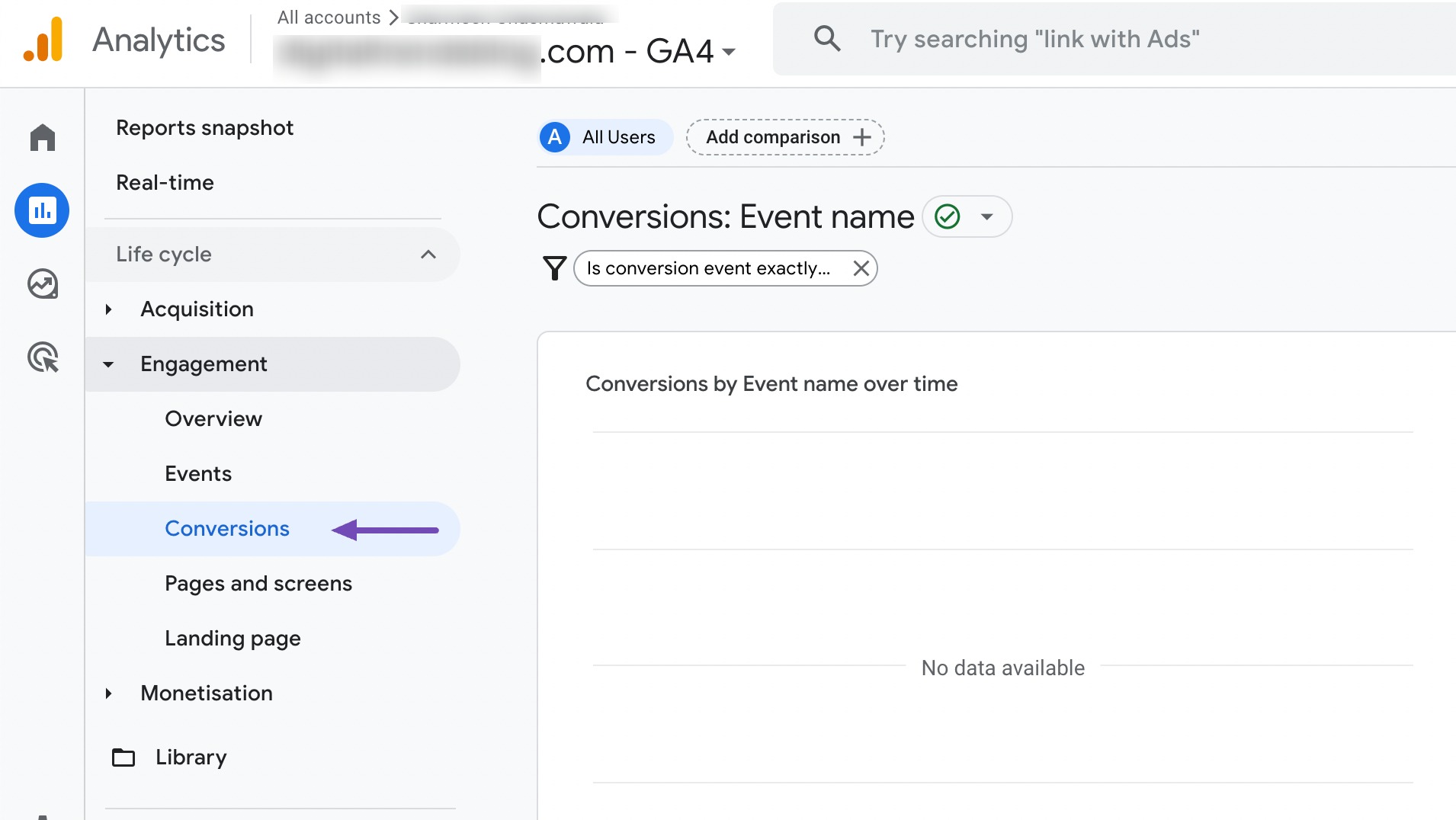
Review which keywords, landing pages, or traffic sources lead to the highest conversion rates. Use this insight to fine-tune your SEO strategy around high-performing keywords and content.
2.8 Average Click Through Rate (CTR)
Click-through rate (CTR) measures the percentage of users who click on your website link after seeing it in the search engine results page (SERP).
This SEO metric determines how well your title tags and meta descriptions capture the attention and interest of searchers.
To calculate CTR, divide the number of clicks by the number of impressions and then multiply the result by 100. For instance, if your site were displayed on the SERP 100 times in a week, with 10 clicks, your CTR would be 10%.
Why CTR Matters
A higher CTR means more people are choosing your link over others, which can:
- Drive more organic traffic
- Improve your search rankings over time
- Indicate that your content is relevant and well-optimized
How to Track Average CTR
To track average CTR, navigate to the Google Search Console, and in the Performance section, you can check the average CTR.
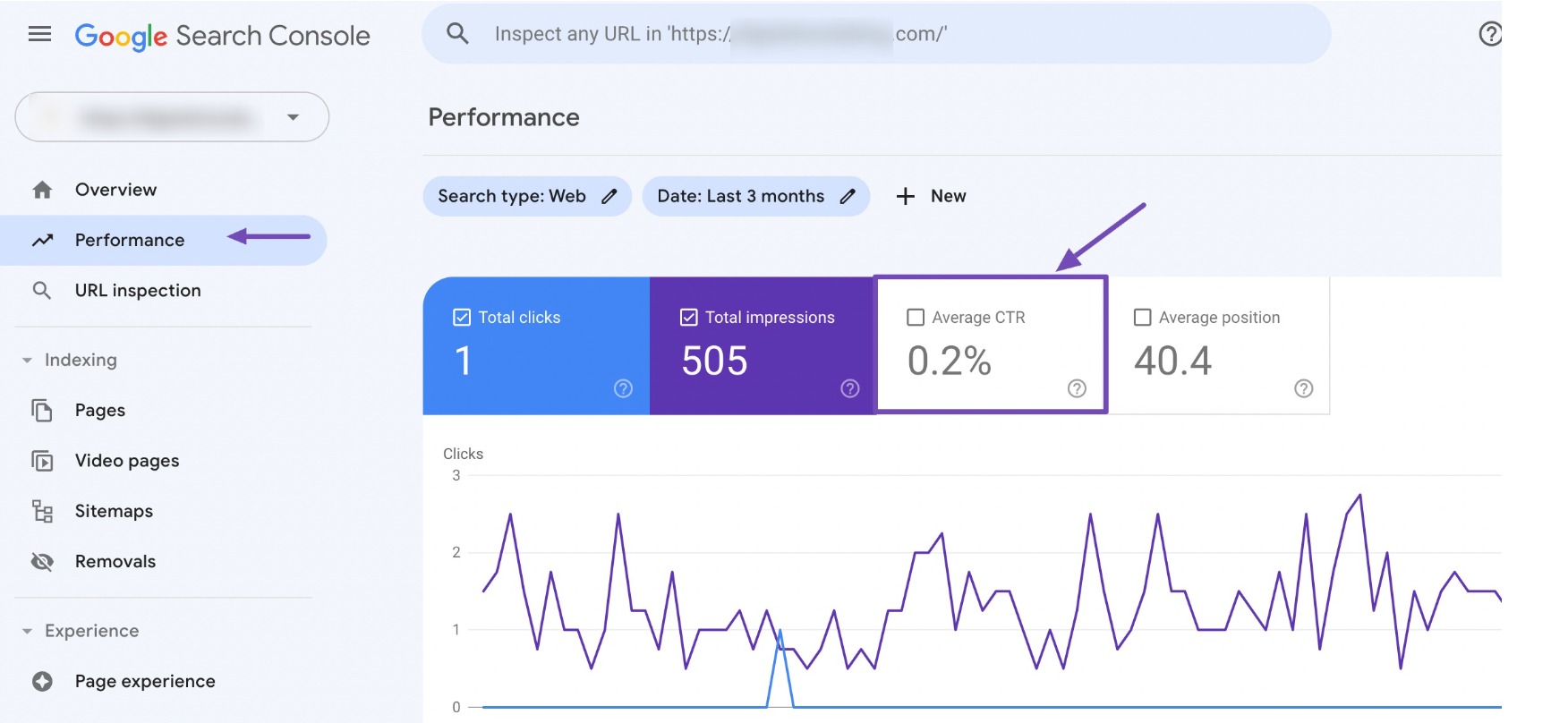
You can also track average CTR in the SEO Performance tab of Rank Math Analytics.

2.9 Page Speed
Page speed measures how quickly your website loads in a user’s browser. It plays a critical role in both user experience and SEO performance.
Why Page Speed Matters
- Improves user experience: Faster-loading pages reduce bounce rates and keep visitors engaged.
- Boosts SEO rankings: Google considers page speed a ranking factor, so faster websites often rank higher in search results.
- Increases conversions: Users are more likely to interact with and convert on fast-loading sites.
Refer to our dedicated tutorial to improve your website’s page speed.
How to Track Page Speed
You can use Google PageSpeed Insights to evaluate your website’s page speed. Enter the URL and click the Analyze button, as shown below.
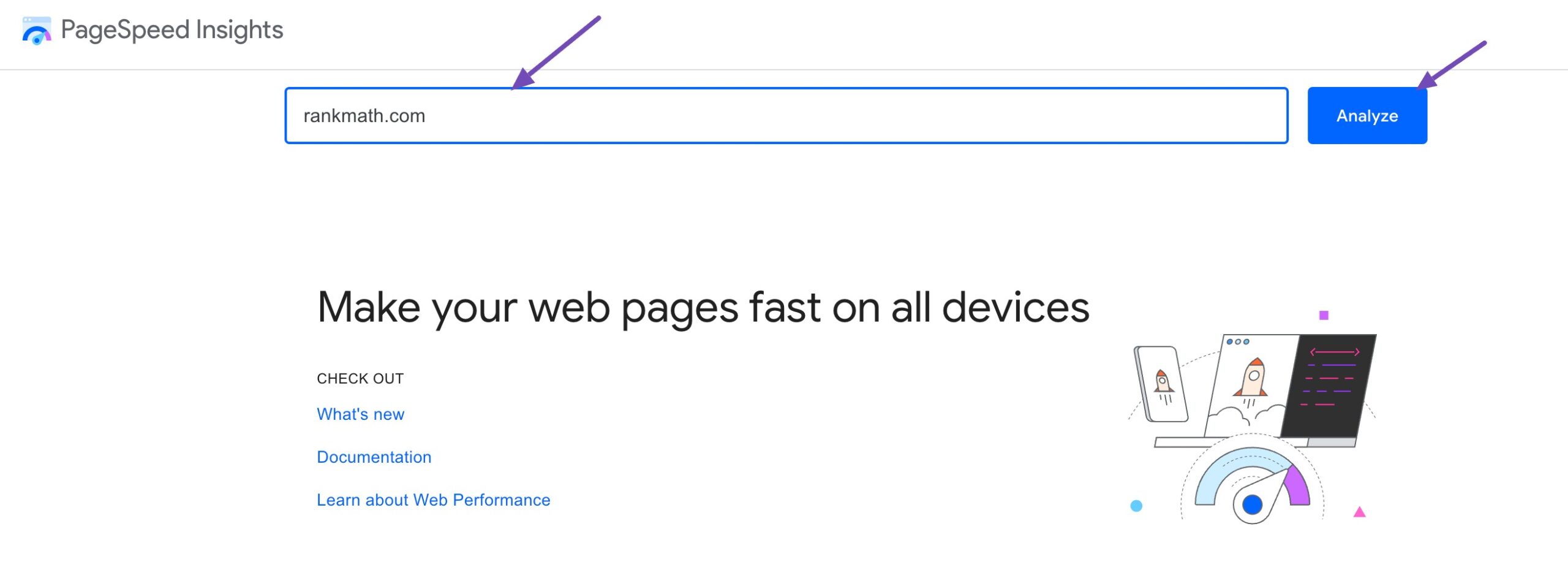
Doing so will provide you with information about the page’s performance and recommendations on how to address any issues.
2.10 Engagement Time
Engagement time is an SEO metric that measures how long visitors actively interact with your webpage. It helps gauge how well your content captures attention and meets user expectations.
A longer engagement time usually indicates that your content is relevant, interesting, and valuable, while a short time may suggest the opposite.
Why Engagement Time Matters
- Reflects content quality and relevance
- Helps identify top-performing pages
- Signals user satisfaction to search engines
- Can correlate with higher conversions and lower bounce rates
How to Track Engagement Time
To track engagement time, use the Report snapshot in GA4.
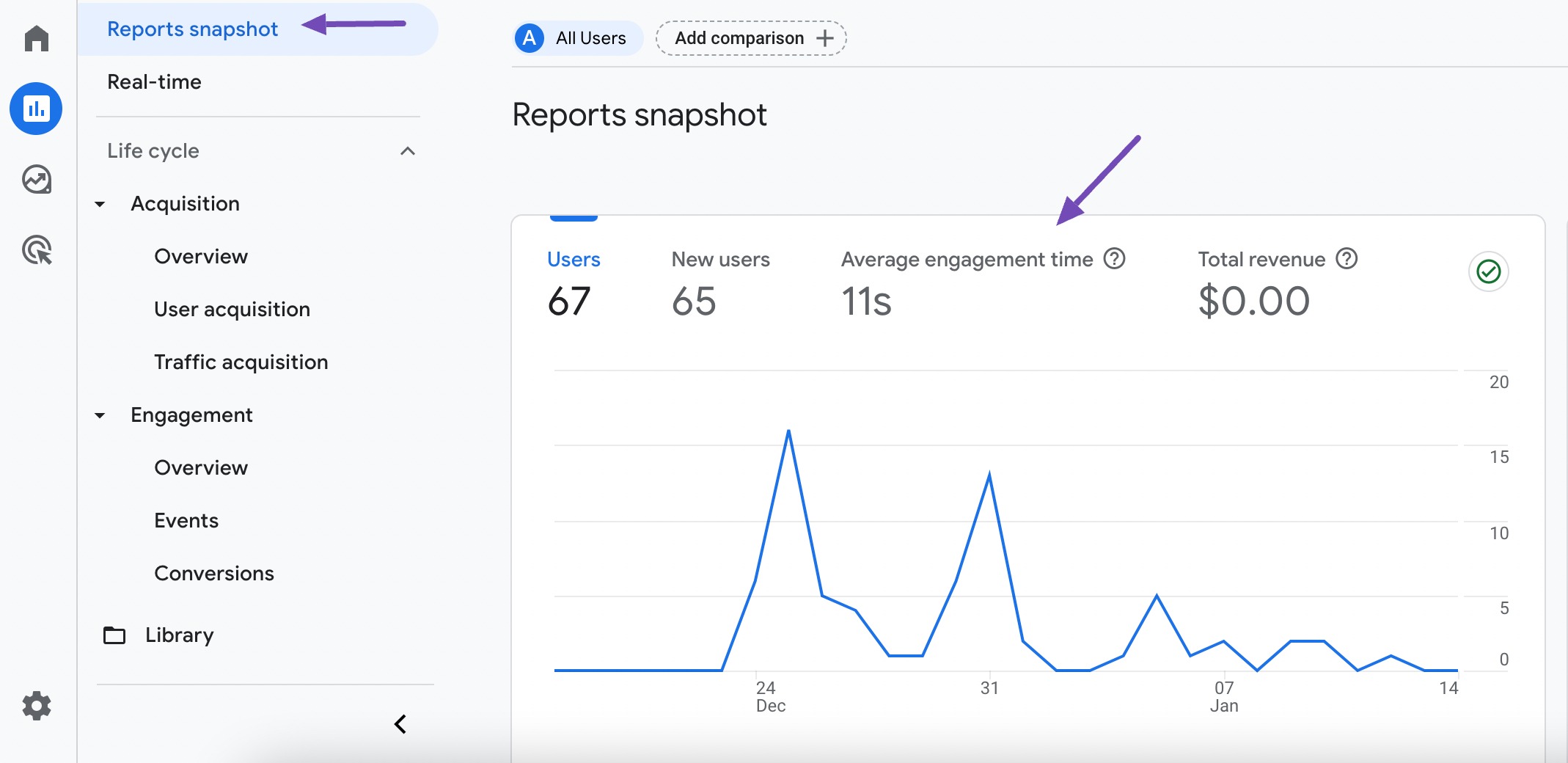
Look for the Average engagement time under user metrics. For deeper insights, go to Engagement → Pages and screens to see engagement per URL.
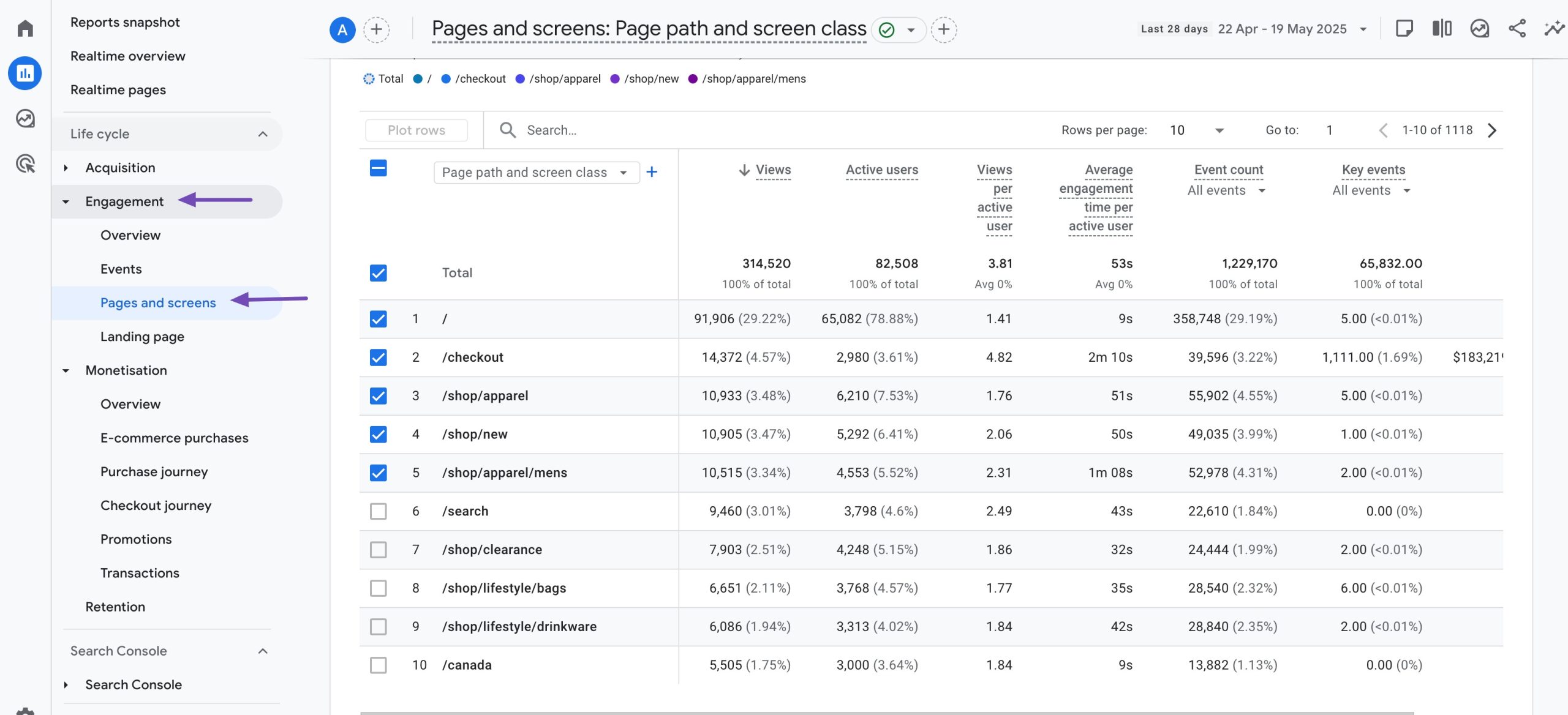
3 Conclusion
Tracking the right SEO metrics is essential for measuring the effectiveness of your strategy and making informed decisions that drive real results.
From monitoring organic traffic and keyword rankings to analyzing page speed, backlinks, and engagement time, each metric provides valuable insights into how your website is performing.
By consistently reviewing these SEO metrics, you can identify what’s working, uncover areas for improvement, and refine your approach to boost visibility, enhance user experience, and ultimately grow your online presence.
Remember, successful SEO isn’t just about rankings; it’s about understanding your audience, delivering value, and using the metrics to guide your strategy toward measurable growth.
If you like this post, let us know by Tweeting @rankmathseo.
